Abstract
In this paper, a new hybrid structure of body-centered cubic lattice-filled thin-walled tube is designed, and the hybrid structure specimens of one-piece printing and split-printing are prepared by laser melting technique. The deformation mode and energy absorption characteristics of the new hybrid structure are investigated by experiments and numerical simulations. Under axial compression, the one-piece printed hybrid structure forms more wrinkles with smaller wavelengths, and the specific energy absorption increases by 12.14% compared with the split-printed structure; under transverse compression, the one-piece printed structure does not show the separation of the thin-walled tube from the lattice, and the specific energy absorption increases by 134.83% compared with the split-printed structure. It is worth noting that the designed hybrid structure has a 112.60% (580.15%) increase in specific energy absorption under axial compression (under transverse compression) compared to the empty tube. The effects of wall thickness, lattice density, and loading rate on the crashworthiness of the hybrid structure were investigated using a validated finite element model. This paper provides a new idea for the preparation of lightweight and high-strength energy-absorbing structures.
1. Introduction
Energy-absorbing materials and structures are widely used in industrial fields such as aerospace technology, high-speed railways, and automobiles, as well as in our daily lives [1,2,3]. The lightweight, high-strength and impact-resistant thin-walled structures are widely used as energy-absorbing structures in aerospace, automotive, and other engineering fields to dissipate the kinetic energy generated by impact and improve the crashworthiness of the system because of their excellent energy absorption efficiency and light weight. They are widely used as structural components, so it is crucial to maintain their structural integrity under various loading conditions [4,5]. Impact loading is one of the main types of loading that these materials may be subjected to in service. Their response to impact loading and post-impact behavior depend on various parameters related to their fabrication, and it is challenging to evaluate the crashworthiness and crash performance of thin-walled structures during the design process.
The main factors influencing the energy absorption characteristics of thin-walled tubes are the deformation mode and the number of folds [6,7,8,9]. Singace et al. [10,11] conducted an in-depth study of the axial compression properties of thin-walled circular metal tubes by experimental methods. It was shown that thin-walled circular metal tubes with different structural dimensions and material properties produce a variety of different deformation modes. Some scholars changed the deformation mode of the structure by changing the cross-section of the thin-walled structure, thus improving the energy absorption performance. Ngoc et al. [12] designed a new circular honeycomb structure by biomimetic design of a wood structure, which increased the specific energy absorption by 45.3% compared with the conventional honeycomb structure. Yang et al. [13] introduced a petal-shaped structure into the circular honeycomb structure, which resulted in a 71.3% increase in specific energy absorption. Deng et al. [14] designed a gradient multilayered cell column based on bamboo structure mimicry, and its specific energy absorption increased from 10.1% to 72.44% compared with an empty tube. The energy absorption performance of the structure needs to be further improved.
In order to further improve the energy absorption of thin-walled structures, some researchers filled thin-walled tubes with lightweight materials, which had an effect on the overall deformation pattern. Thus, some studies improved the energy absorption performance of the whole structure by filling it with lightweight foam and lattice structures [15]. Aktay et al. [16] filled thin-walled tubes with aluminum foam and found that the number of specimens folded became larger, and the specific energy absorption of specimens filled with 0.35 g/cm−3 aluminum foam increased by 32.13% compared to empty tubes. Toksoy et al. [17] investigated the compressive properties of different foam-reinforced circular tubes. Studies showed that foam filling can change the deformation pattern of circular tubes, thus improving the energy absorption performance. In addition to the commonly used foam filling, lattice has been used as a lightweight structure to reinforce thin-walled energy-absorbing structures [18,19,20,21]. Adil et al. [22] embedded BCC and BCC-Z lattice structures in thin-walled tubes for axial compression, and the specific energy absorption of the two filled structures was increased by 29% and 51% through optimization. Li et al. [23] combined single cell lattice and showed that filling the corner regions of the tube with lattice or increasing the number of cells in the corner regions resulted in better crashworthiness. Liu et al. [24] designed a lattice structure in multi-element thin-walled tubes and compared the energy absorption effects of tubes filled with different elements. Cetin et al. [25] designed a lattice structure with gradient changes, which had a specific energy absorption 3.3 times higher than a uniformly distributed structure. Cengiz et al. [26] designed a three-point bending experiment by filling the BCC lattice into a thin-walled tube, and its energy absorption increased by 84% compared to an empty tube, but the interaction between the filling material and the thin-walled structure was still to be clarified.
Some scholars conducted experiments and finite element simulations on the effect of the interaction of lightweight filled structure reinforced thin-walled tubes on the energy absorption performance and found that the direct embedding of the foam structure in the thin-walled tube would cause separation between the two during compression [27]. Cui et al. [28] showed that bonding foam to thin-walled tubes provides better crashworthiness than unbonded filled tubes, with about a twofold increase in energy absorption. Zhang et al. [29] investigated the effect of epoxy resin adhesive on the structural crashworthiness of aluminum foam and thin-walled tubes and found that the filled tubes after bonding at room temperature had 13.04% higher mean crush force and 3.37% higher specific energy absorption than the unbonded tubes. However, the lightweight filler and thin-walled tube were prepared separately, and the mixed structure was made by two-phase assembly or bonding, and the interface separation phenomenon occurred under the load, which affected the energy absorption effect. Bai et al. [30] filled the BCC lattice array into the thin-walled tube for an axial compression test but only considered a single working condition and selected AlSi10Mg material with poor ductility, which did not form folding deformation, resulting in a poor energy absorption effect.
With the development of 3D printing technology, it has become possible to print thin-walled tubes with improved lattice structure in one piece. In this paper, a new hybrid energy-absorbing structure with lattice-filled thin-walled tubes was designed, and one-piece printed and split-printed samples were prepared by laser melting technology. The deformation mode and energy absorption characteristics of the hybrid structure were investigated by experiments and numerical simulations. The effect of wall thickness, lattice density, and loading speed on the crashworthiness of the hybrid structure were also parametrically analyzed by the validated finite element model.
2. Materials and Methods
2.1. Geometric Description
Two hybrid structures of thin-walled lattice-reinforced tubes were designed as shown in Figure 1, one structure for one-piece printing and the other for split-printing and reassembly. Figure 1a shows the integrated printing BCC lattice reinforcement tube (IPLT), and Figure 1b shows the non-integrated printing BCC lattice reinforcement tube (NPLT). IPLT is a 3D printing process in which the lattice structure and the thin-walled tube are prepared as a whole; NPLT is a 3D printing technology in which the lattice structure and the thin-walled tube are prepared separately, and then the two are simply assembled together.

Figure 1.
Hybrid structure. (a) One-piece printing hybrid structure. (b) Split-printing hybrid structure.
Three specimens of each type were prepared for the axial compression test and transverse compression test for IPLT and NPLT. The dimensions used for axial compression were as follows: thin-walled tubes printed in one piece were (dimensions in brackets are those of the bore), given in transverse, transverse, axial direction, with a wall thickness of 1 mm; The diameter of the lattice rod was 1.3 mm, and the size of each cell envelope of the lattice rod was . The single cell structure was stacked in the numbers along the coordinate axes x, y, and z. For transverse compression, the specimens were 40 mm in length and width, and the single cell structure was manufactured in a stack along the coordinate axes x, y, and z directions.
Using laser melting (SLM) technology with excellent forming quality, the samples required for the experiments were fabricated using the EP-M450 metal 3D printer. The 316 L stainless steel material was selected for preparation. With its mechanical properties in the hydraulic universal testing machine under the standard tensile test, a constant loading rate of 1 mm/min, and two tensile tests, the measured stress–strain curve is as shown in Figure 2, and the calculation of 316 L stainless steel mechanical parameters is as shown in Table 1.

Figure 2.
Stress–strain curve of 316 L stainless steel material.

Table 1.
Mechanical properties of 316 L stainless steel materials.
To obtain information about the surface morphology and geometric features of the sample, a scanning electron microscope was used for observation, as shown in Figure 3. From the figure, it can be observed that the outline of the rod of the lattice structure is clear, no obvious micro-cracks and porosity, but some unmelted metal powder is attached to the rod. This was due to the thermal diffusion between a small amount of powder and the structure during the SLM printing process, which caused these powders to stick to the surface of the rod, resulting in a rough surface of the structure. It can also be clearly seen that the lattice structure and the thin-walled tubes are seamlessly blended and printed in one piece, with a more regular surface.
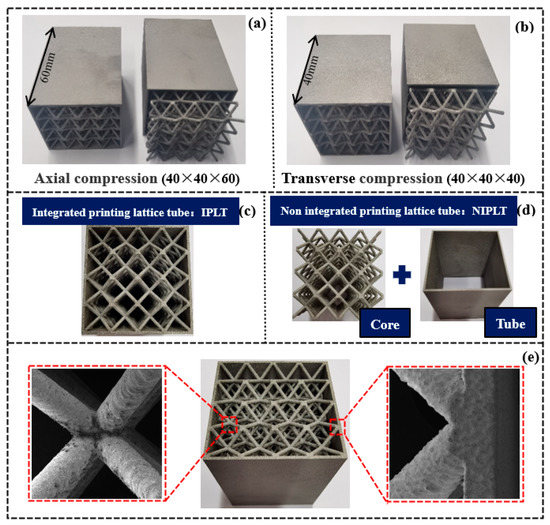
Figure 3.
Lattice structure reinforced thin-walled tube hybrid structure specimen. (a) Axial compression specimen. (b) Transverse compression specimen. (c) Top view of one-piece printed hybrid structure. (d) Split-printed part. (e) Specimen morphology under electron microscope.
2.2. Experimental Setup
Both IPLT and NPLT specimens were subjected to compression tests at room temperature using an Instron electronic universal materials testing machine, as shown in Figure 4. The force-displacement curves are automatically collected in the data acquisition system, and the loading area is uniformly illuminated by a cool LED board and recorded in real time by a camera. The tester has a capacity of 100 kN and performs quasi-static uniaxial compression tests at a speed of 2 mm/s under displacement drive. For axial compression, the specimen stops when it is compressed by 40 mm; for transverse compression, the specimen is compressed by 25 mm. All tests were repeated three times to average the results.
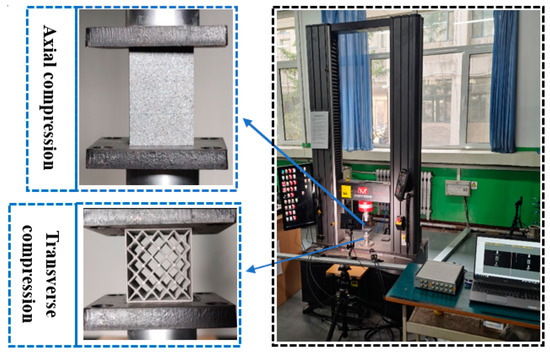
Figure 4.
Compression experimental setup.
2.3. Crashworthiness Index
To better investigate the differences in mechanical properties between the IPLT and NPLT specimens, six crashworthiness indices were introduced for evaluation. Energy absorption (EA), specific energy absorption (SEA), peak crushing force (PCF), mean crushing force (MCF), crushing force efficiency (CFE), and undulation of load capacity (ULC) were used to evaluate the crashworthiness of the structure.
EA is the total energy absorbed during the deformation of the object, which can be obtained by integrating the load-displacement curve with the following expression (where x is the compression displacement under load):
SEA is the energy absorbed per unit mass under load and is the total absorbed energy divided by the total mass, expressed as follows (where m is the total mass of the structure):
PCF is the peak value of the initial force under load, which is the maximum value of the force obtained after the specimen begins to deform.
MCF is the arithmetic mean of the load-displacement curve under load, and its expression is:
CFE is the stability index of the load during the collision; the higher the CFE, the better the stability. The expression is:
ULC is a characterization of the smoothness of the load-displacement curve, the smaller its value, the smoother the curve and the more stable the overall energy-absorbing structure. The expressions are:
2.4. Finite Element Model
In this paper, ABAQUS, a commercial finite element software, was used for the numerical simulation of the quasi-static compression test, and the finite element models of IPLT, NPLT, and their individual parts were built according to the corresponding dimensions, as shown in Figure 5. Each part of the model was placed in the lower fixed rigid plate and the upper movable rigid plate. The fixed-end rigid plate was restricted from movement and rotation in all directions, and the moving-end rigid plate was allowed to move only in the vertical direction. Theoretically, if the kinetic energy is less than 5% of the internal energy, the dynamic effect can be ignored. The amplified loading speed can be used to represent the quasi-static loading situation. In this experiment, the loading speed in the finite element simulation was set to 1 m/s [31]. The thin-walled tube adopted a four-node shell unit, the upper and lower rigid plate selected a rigid unit, and the point structure was a tetrahedral solid unit. There was no bond between the thin-walled tube of NPLT and the lattice structure, so it was necessary to set up no penetration between the lattice structure and the thin-walled tube.
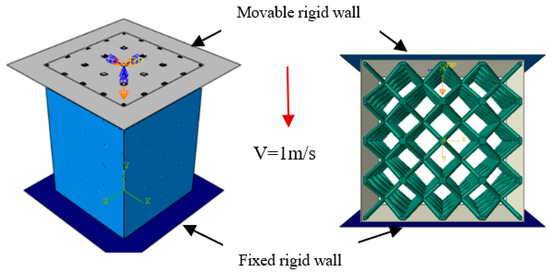
Figure 5.
Simulation diagram of compression simulation.
In the interaction module, the total friction coefficient was set to 0.2 [32], the contact constraint was general contact, and the contact behavior in the normal direction was defined as “hard contact”. For IPLT, a face-to-face constraint was used between the thin-walled tube and the lattice structure. Reference points were set at the center of the upper and lower rigid plates to record the displacement and reaction force, which is convenient for drawing images to export data during post-processing. Under load, the initial geometric defect affects the deformation pattern of the specimen, so the first-order bending mode 0.02 was set in the numerical simulation to simulate the effect of defects on compressive deformation [33,34,35]. It was necessary to select the point array with a thin-walled tube mesh size with a small energy absorption error and moderate computation time as much as possible. In this regard, mesh convergence tests were conducted to test the time required for different mesh densities and the corresponding energy absorption to determine the optimal mesh density of the proposed finite element model, and the results of the convergence tests are shown in Figure 6. The size of the tubular structure unit was selected as 1.00 mm, and the size of the lattice structure unit was selected as 0.42 mm.
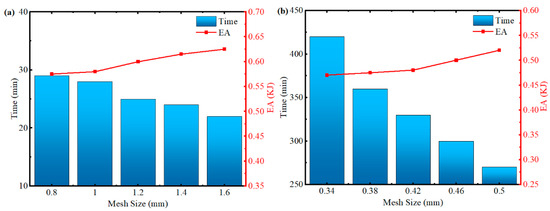
Figure 6.
Mesh convergence analysis. (a) Variation of computation time and energy absorption from 0.8 to 1.6 mm for the mesh size of the thin-walled tube. (b) Variation of computation time and energy absorption from 0.34 to 0.5 mm for the mesh size of the lattice structure.
3. Results
3.1. Axial Compression
Figure 7 shows the deformation pattern of the specimen under quasi-static axial compression for the experimental and numerical simulations. Figure 7a shows the experimental and simulated deformation plots of IPLT under different compression displacements. As can be seen, since the lattice structure of IPLT and the thin-walled tube were made of one piece, there was a constraint effect between them, which made the thin-walled tube fold inward and outward compared with the original position, and the overall deformation was regular, forming a total of three complete folding regions. When a downward compressive load was applied at the beginning, an initial deformation occurred at the upper end of the specimen, with a bulge at the front view position 8 mm from the upper rigid plate and an inward depression on both sides. As the load displacement continued to increase, a bulge was formed at the upper and lower positions of the recessed area on both sides, and a depression was formed at the corresponding front view position, and then the fold was gradually formed. Figure 7b shows the experimental and simulated deformation plots of NPLT under different compressive displacements. As can be seen, since the lattice of NPLT was directly embedded in the thin-walled tube, the two were extremely easy to separate when an external load was applied. The thin-walled tube was deformed outward from its original position, creating a total of two complete folded areas. Under load, the specimen produced an initial deformation in the center position. This fold gradually increased in size as the load distance gradually increased. This buckle area was completely compressed before it produced further buckles in its upper and lower positions. The reason the initial deformation points of the experimental and simulated specimens were different is that the specimens will inevitably have defects during processing, and during compression, the specimens will be the first to be damaged at the defect or stress concentration, but this does not affect the energy absorption characteristics of the entire structure.

Figure 7.
Comparison of deformation results between experimental results and numerical simulations. (a) Deformation process of IPLT under axial compression. (b) Deformation process of NPLT under axial compression.
The load-displacement curves of IPLT and NPLT were obtained by experimental and numerical simulations, as shown in Figure 8. The load-displacement curve of the point-reinforced hybrid structure can be divided into three stages: first, the load increased rapidly to reach the peak stress. This was because the thin-walled tube had high rigidity and high strength, so when the strain was small, the energy was almost absorbed by the thin-walled tube. After that, as the strain increased, the specimen was folded and the thin-walled tube was gradually deformed under the load, losing its original stiffness and strength, and the curve fluctuated smoothly up and down. Finally, the specimen was gradually compressed to the compression stage, and the curve rose rapidly. Figure 8a,b shows the load-displacement curves of IPLT and NPLT under axial compression. By comparison, it can be observed that the load-displacement curve of IPLT is higher than that of NPLT, which produced better plateau stress and better energy absorption performance in the fluctuation phase. This was because when the thin-walled tube folded and deformed, it lost its original strength and stiffness, and the interaction between the thin-walled tube and the lattice structure dominated. The hybrid structure printed by SLM technology was more ductile, and the lattice structure was never separated from the thin-walled tube, making the bonding effect between them stronger. The improved energy absorption effect can also be seen in the small graph.
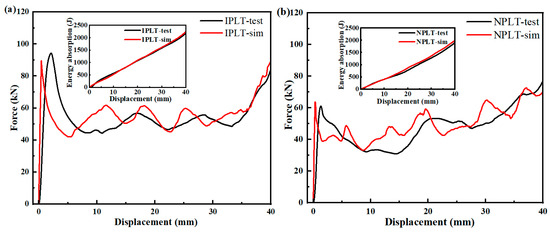
Figure 8.
Experimental results and numerical simulation results. (a) Load-displacement curve of IPLT under axial compression. (b) Load-displacement curve of NPLT under axial compression.
3.2. Transverse Compression
Figure 9 shows the deformation patterns of the specimens under quasi-static transverse compression for the experimental and numerical simulations. Figure 9a shows the experimental and simulated deformation of the IPLT under different compression displacements, with the overall formation of two folded regions. Under the load, the internal lattice structure was the first to collapse and deform at the diagonal, and the thin-walled tube produced a bulge at the diagonal owing to the one-piece pressure interaction. As the load distance continued to increase, the thin-walled tube began to form a folded deformation that was not symmetrical to this diagonal. Figure 9b shows the experimental and simulated deformation plots of the NPLT under different compression displacements. Since there was no confinement effect between the lattice structure and the thin-walled tube, the thin-walled tube broke outward and the lattice gradually collapsed. The specimen did not form a fold, only a bending deformation.
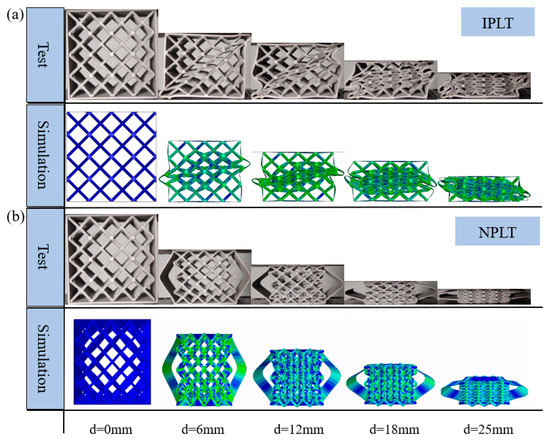
Figure 9.
Comparison of deformation results between experimental results and numerical simulations. (a) Deformation process of IPLT under transverse compression. (b) Deformation process of NPLT under transverse compression.
Figure 10 shows the load-displacement curves of the IPLT and NPLT under transverse compression. From the figure, it can be seen that the IPLT generated a peak stress and then dropped rapidly to produce folding, with two falling and then rising phases, corresponding to the formation of two folding regions. When the load displacement reached 22 mm, the specimen was compressed to densification and the curve rose. The overall curve showed higher platform stress and better energy absorption performance. In contrast, NPLT had a more horizontal load-displacement curve after generating a smaller peak stress. This was because the advantage of the high strength and high rigidity of the thin-walled tube of NPLT under transverse compression was no longer obvious, and the interaction between the lattice structure and the thin-walled tube disappeared completely, and the specimen did not produce folding, but only bending deformation. It showed lower platform stress and worse energy absorption in the force-displacement diagram. Because of the complete separation of the lattice structure from the thin-walled tube, the specimen still did not reach the densified state when the load displacement reached 25 mm.
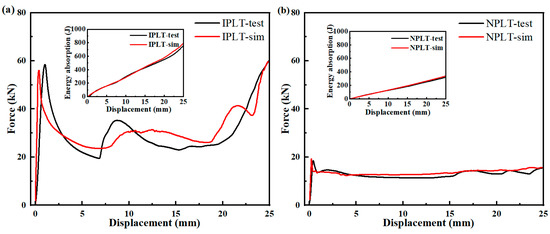
Figure 10.
Experimental and numerical simulation results. (a) Load-displacement curve of IPLT under transverse compression, (b) Load-displacement curve of NPLT under transverse compression.
3.3. Finite Element Model Validation
To better demonstrate the consistency of the numerical simulations, the experimental and simulated energy absorption at the point where the IPLT and NPLT specimens reach compression were calculated and the error values of their energy absorption were compared, and the error was taken as (simulated value-experimental value)/experimental value. For axial compression, selected from 0 to 40 mm, the error between the experiment and simulation was 2.80% for IPLT and 4.75% for NPLT. For transverse compression, selected from 0 to 25 mm, the error between experiment and simulation was 4.67% for IPLT and 5.74% for NPLT. In summary, it can be seen that the trends of the experiments and simulations were basically in agreement, which proved that the results of the experiments and simulations were in agreement with each other. The error was mainly due to the machining process and the measurement accuracy of the printed sample. To further observe the folding pattern of the thin-walled tube, the fully compressed one-piece printed hybrid structure of the axial compression specimen was line cut to observe the specimen profile and compared with the profile results of the numerical simulation, as shown in Figure 11. The folding pattern of the IPLT under axial compression can be seen in the figure, forming three folding regions. The experimental and numerical simulations presented the same folding scenario, including the same number of folds and similar fold lengths, once again demonstrating the consistency of the simulations. Since the result of the transverse compression is easy to observe, the deformed fold can be clearly seen without wire cutting.
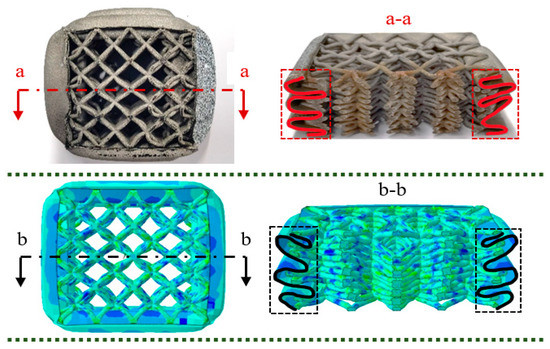
Figure 11.
Experimental profile (a-a) and numerical simulation (b-b) profile of the wire cut after the completion of axial compression.
3.4. Crashworthiness Index Analysis
The crashworthiness indexes of specimens IPLT, NPLT, and their parts under axial compression were calculated at 67% compression as shown in Table 2, from which Figure 12 was plotted. Since SEA is the ratio of EA to mass, and the mass of IPLT and NPLT were equal, the law of EA was consistent with SEA. It can be seen from the figure that the SEA of IPLT and NPLT increased by 112.60% and 89.57%, respectively, compared to the empty tube; the MCF of IPLT and NPLT increased by 282.68% and 241.27%, respectively, compared to the empty tube; the CFE of IPLT and NPLT increased by 32.48% and 48.2%, respectively, compared to the empty tube. It was proved that the shape of the thin-walled tube filled with lattice structure under axial compression will improve the load-bearing capacity, energy absorption, and stability of the specimens. The SEA of IPLT was 12.14% higher than that of NPLT; the MCF of IPLT was 12.13% higher than that of NPLT. The results showed that the one-piece printed structure was better than the split-printing in terms of specific energy absorption and mean load capacity. However, in terms of CFE, NPLT was better because the one-piece printing provided greater energy absorption while generating a higher initial peak force, resulting in a lower overall CFE.

Table 2.
Crashworthiness index of specimens under axial compression.
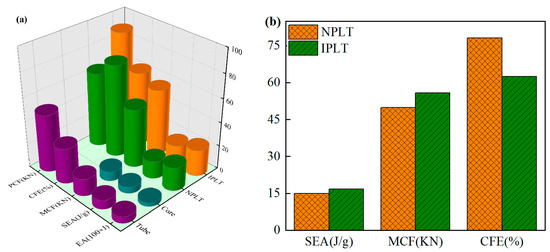
Figure 12.
Crashworthiness characteristics of specimens under axial compression. (a) Crashworthiness index of specimens. (b) Comparison of crashworthiness of IPLT and NPLT, including SEA, MCF, CFE.
Table 3 shows the crashworthiness indexes of IPLT, NPLT, and their parts at 62.5% compression under transverse compression, from which Figure 13 is drawn. It can be seen from the figure that the SEA of IPLT and NPLT increased by 580.15% and 189.31%, respectively, compared with the empty tube; the MCF of IPLT and NPLT increased by 1122.31% and 420.38%, respectively, compared with the empty tube; the CFE of IPLT and NPLT increased by 39.60% and 54.42%, respectively, compared with the empty tube. Therefore, the shape of filling the thin-walled tube with lattice structure under transverse compression will improve the load-bearing capacity, energy absorption, and stability of the specimen. The SEA of IPLT was 134.83% higher than that of NPLT; the MCF of IPLT was 134.89% higher than that of NPLT. For energy absorption and load capacity, IPLT was more than twice that of NPLT. Such a large gap was due to the fact that the split-printed structure did not have the constraining effect of the lattice, and the entire specimen was completely separated without forming a fold, producing only bending deformation, which produced deformation results similar to the empty tube.

Table 3.
Crashworthiness index of test pieces under transverse compression.
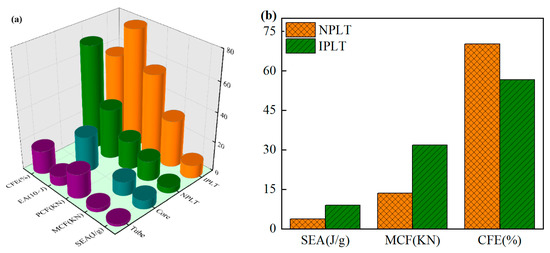
Figure 13.
Crashworthiness characteristics of specimens under transverse compression. (a) Crashworthiness index of specimens. (b) Comparison of crashworthiness of IPLT and NPLT, including SEA, MCF, CFE.
3.5. Mechanism of Coupling Action
3.5.1. Interaction of Lattice with Thin−Walled Tubes
To better demonstrate the difference in crashworthiness between the one-piece printed structure and the split-printed structure, the load-displacement curves of the one-piece printed hybrid structure, the split-printed hybrid structure, the thin-walled tube, and the dot-matrix structure were plotted by numerical simulation, as shown in Figure 14. The energy absorption of the hybrid structure was mainly due to the folding deformation of the thin-walled tube, the bending deformation of the lattice structure, and the interactions generated between them. The thin-walled tube and the lattice structure were compressed axially separately to show the effect of the interaction between the lattice structure and the thin-walled tube on the energy absorption performance, as shown in Figure 14a,b. The two sets of data were summed and processed to obtain the purple dashed curve in the figure, and it can be seen that the summed curve is lower than the load-displacement curves of IPLT and NPLT. The dark blue and light blue shaded parts are the difference between IPLT, NPLT and the summed curve. The SEA of IPLT was 145.20% higher than the summed curve; the SEA of NPLT was 118.66% higher than the summed curve. Similarly, a separate transverse compression was performed for the thin-walled tube with the lattice structure, as shown in Figure 14c,d. The SEA of the IPLT was 161.10% higher than the summed curve, and the SEA of the NPLT was 11.19% higher than the summed curve. Thus, the interaction between the lattice structure and the thin-walled tube provided better energy absorption properties for the hybrid structure, and the one-piece printing made this interaction even more effective.
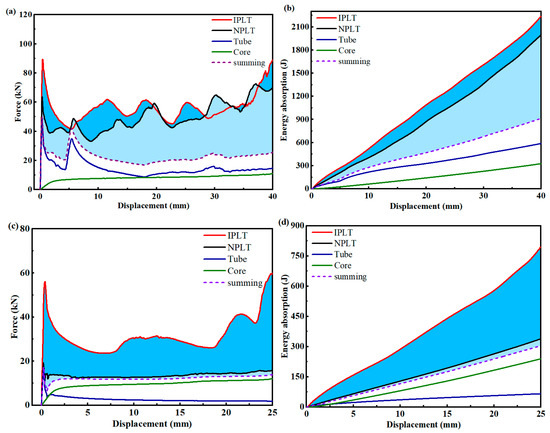
Figure 14.
Mechanical response of specimen under compressive load. (a) Load-displacement curve of specimen in axial compression. (b) Energy absorption-displacement curve of specimen in axial compression. (c) Load-displacement curve of specimen in transverse compression. (d) Energy absorption-displacement curve of specimen in transverse compression.
3.5.2. Deformation Mechanism
To better show the difference between IPLT and NPLT in the folding deformation of thin-walled tubes, a finite element model was used to capture a series of reference points of the thin-walled outer tube to map the axial compression deformation of the thin-walled tube. Based on the original coordinate system, the coordinate system yoz plane was placed on the outer tube wall, and the coordinate origin was set at the midpoint of the lower end of the thin-walled tube to establish a new local coordinate system, as shown in Figure 15a. The horizontal axis of the deformation diagram indicated the relative position of the selected series of reference points in the axial direction (), and the vertical axis indicated the relative deflection of this series of points in the transverse direction (). As can be seen in Figure 15b,c the thin-walled tube folding case, IPLT had positive and negative values; the thin-walled tube was folded inward and outward compared to the original position, forming more folds and smaller wavelengths. The value of NPLT was positive, and the thin-walled tube was folded outward compared to the original position, forming less folding and a larger wavelength, which was the reason for the poorer energy absorption of the specimen.
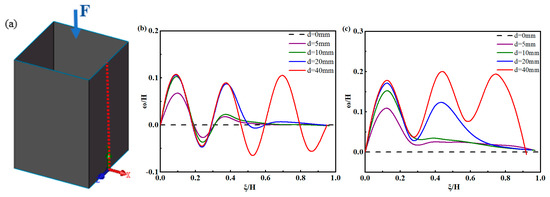
Figure 15.
Transverse deflection under axial compression displacement. (a) Definition of the local coordinate system. (b) Relative deflection of the IPLT thin-walled tube. (c) Relative deflection of the NPLT thin-walled tube.
For transverse compression, the same finite element model was used to capture a column of reference points on the thin-walled tube to map the transverse compression deformation of the thin-walled tube wall. To establish a local coordinate system, the coordinate origin was set to the midpoint of the tube wall, the y-direction was the compression direction of the transverse pressure, the x-axis direction pointed to the outside of the thin-walled tube, and the deformation diagram of the thin-walled outer tube was drawn, as shown in Figure 16a. The horizontal axis of the deformation diagram indicated the relative deflection of the thin-walled tube in the x-direction (), and the vertical axis indicated the relative position of the thin-walled tube in the y-direction (). The deformation pattern of the thin-walled tube can be seen in Figure 16b,c, where the IPLT had positive and negative values, and the thin-walled tube was folded inward and outward compared to the original position, and the wavelength was smaller. The NPLT was numerically greater than zero, forming a flexural deformation and not producing a fold, making its energy absorption effect much lower.

Figure 16.
Transverse deflection under transverse compression displacement. (a) Definition of the local coordinate system. (b) Relative deflection of the IPLT thin-walled tube. (c) Relative deflection of the NPLT thin-walled tube.
4. Parameter Analysis
In this section, the effects of thin-walled tube wall thickness, lattice density, and different loading speeds on the crashworthiness of one-piece printed hybrid structures are investigated by numerical simulations under axial and transverse compression.
4.1. Effect of Thin−Walled Tube Thickness on Structural Crashworthiness
To study the effect of thin-walled tube thickness on energy absorption, the same thickness variation was selected for axial compression and transverse compression with wall thicknesses of t = 0.5, 1.0, 1.5, 2.0 and 2.5 mm.
The crashworthiness indices of IPLT specimens with different wall thicknesses under axial compression at 67% compression are shown in Table 4. Figure 17a shows the load-displacement curves for different wall thicknesses, and Figure 17b shows the variation of SEA and CFE for different wall thicknesses. For one-piece printed hybrid structures with thin wall thickness, the interaction between the lattice structure and the thin-walled tube played an important role. However, as the thin-walled tube gradually became thicker and the specimen became more robust, the deformation pattern of the one-piece printed hybrid structure became more similar to the deformation effect of the empty tube and partially affected the deformation pattern of the lattice structure, which in turn affected the energy absorption performance. As the thickness of the thin-walled tube increased, the load-displacement curve became higher. The wall thickness increased from 0.5 to 2.5 mm, and the SEA of IPLT increased by 140.81%; MCF increased by 510.18%. However, the thin-walled tube was too thick, which led to larger load fluctuations and poorer energy absorption stability of the structure. As the thin-walled tube thickness increased from 0.5 to 2.5 mm, the PCF of IPLT increased by 714.62%, resulting in a 20.11% decrease in CFE.

Table 4.
Crashworthiness index of IPLT with different wall thicknesses under axial compression.
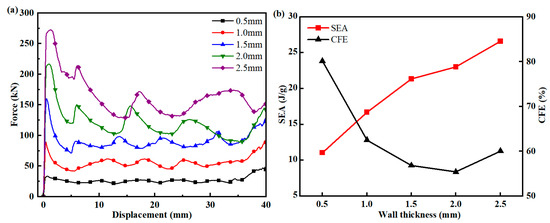
Figure 17.
Comparison of IPLT with different wall thicknesses under axial compression. (a) Load-displacement curves for different wall thicknesses. (b) Comparison of crashworthiness of IPLT with different wall thicknesses, including SEA, CFE.
The crashworthiness indices of IPLT specimens with different wall thicknesses under transverse compression at 62.5% compression are shown in Table 5. Figure 18a shows the load-displacement curves for different wall thicknesses, and Figure 18b shows the variation of SEA and CFE for different wall thicknesses. The energy absorption performance of different wall thicknesses can be seen in the figure, and the load-displacement curve gradually increases with the increase in thin-walled tube thickness. As the wall thickness increased from 0.5 to 2.5 mm, the MCF of IPLT increased by 510.18%. However, the difference was that as the energy absorption capacity of the structure increased, the SEA first increased and then decreased. The SEA of IPLT increased from 7.93 to 9.68 J/g and then decreased to 8.96 J/g. This was because as the wall thickness increased, the internal lattice became smaller compared to the mass of the thin-walled tube, which affected the interaction between the thin-walled tube and the lattice, and the overall deformation pattern was affected by the overly thick wall. Similar to the axial pressure, the thin-walled tube was too thick; it increased the fluctuation of the load and worsened the structure’s energy absorption stability. As the thin-walled tube thickness increased from 0.5 to 2.5 mm, the PCF of IPLT increased by 582.57%, resulting in a 57.78% decrease in CFE.

Table 5.
Crashworthiness index of IPLT with different wall thicknesses under transverse compression.
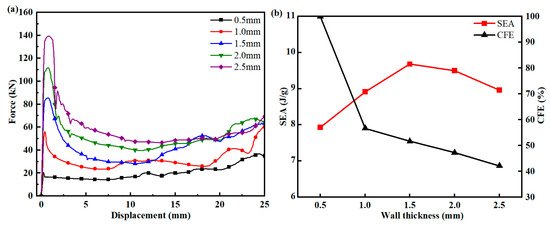
Figure 18.
Comparison of IPLT with different wall thicknesses under transverse compression. (a) Load-displacement curves for different wall thicknesses. (b) Comparison of crashworthiness for different wall thicknesses, including SEA, CFE.
4.2. Effect of Lattice Density on Structural Crashworthiness
In addition to the thin-walled tube thickness, which affects the overall crashworthiness, the lattice structure also plays a crucial role. To study the effect of different lattice densities on structural energy absorption, the same lattice density variations were selected for axial compression and transverse compression, and the diameters of the lattice bars were ρ = 0.9, 1.1, 1.3, 1.5 and 1.7 mm.
The crashworthiness indices of IPLT specimens with different lattice densities under axial compression are shown in Table 6. Figure 19a shows the load-displacement curves for different lattice densities, and Figure 19b shows the variation of SEA and CFE for different lattice densities. For smaller densities of one-piece printed hybrid structures, the folding pattern of thin-walled tubes played a large role in the energy absorption of the hybrid structure. As the lattice density continued to increase, the constraint between the thin-walled tube and the lattice structure increased, resulting in smaller folds and higher overall energy absorption. The lattice density increased from 0.9 to 1.7 mm, and the SEA of IPLT increased by 54.01%; MCF increased by 153.84%. Under axial loading, the stability of the hybrid structure improved with increasing lattice density, which increased from 0.9 to 1.7 mm, and the PCF of IPLT increased only by 33.08%; the CFE of IPLT increased by 42.23%. The increase in lattice density did not produce an extremely high peak crushing force relative to the wall thickness. Therefore, filling the thin-walled tube with lattice density structures was more effective than increasing the wall thickness of the thin-walled tube, which not only greatly improved the overall energy absorption, but also avoided higher peak stresses.

Table 6.
Crashworthiness index of IPLT with different lattice densities under axial compression.
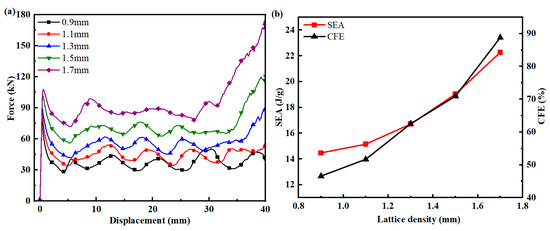
Figure 19.
Comparison of IPLT with different lattice densities under axial compression. (a) Load-displacement curves for different lattice densities. (b) Comparison of crashworthiness for different lattice densities, including SEA, CFE.
The crashworthiness indices of IPLT with different lattice densities under transverse compression are shown in Table 7. Figure 20a shows the load-displacement curves for different lattice densities, and Figure 20b shows the variation of SEA and CFE for different lattice densities. With the increase in the lattice density, the energy absorption and the load-carrying capacity of the structure were improved. With the increase in the lattice density from 0.9 to 1.7 mm, the SEA of IPLT increased by 143.67%; MCF increased by 301.43%. The structural stability gradually improved with the increase in the grating density. As the grating density increased from 0.9 to 1.7 mm, the CFE of IPLT increased by 60.98%.

Table 7.
Crashworthiness index of IPLT with different lattice densities under transverse compression.
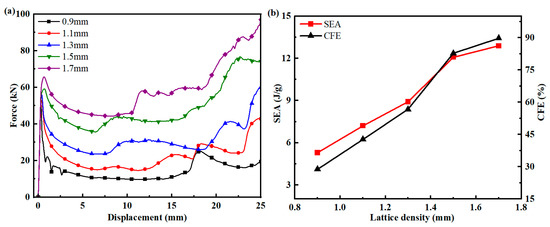
Figure 20.
Comparison of IPLT with different lattice densities under transverse compression. (a) Load-displacement curves for different lattice densities. (b) Comparison of crashworthiness for different lattice densities, including SEA, CFE.
4.3. Effect of Loading Speed on Structural Crashworthiness
In practical engineering cases, energy-absorbing structures not only encounter quasi-static loading modes but are also often subjected to dynamic shock loads, so it is crucial to study the dynamic response of hybrid structures at different velocities. In the quasi-static loading mode, the lower loading velocity will keep the overall structural deformation and stress distribution in equilibrium at all times. However, in the dynamic loading mode, because of the inertia of the object, the deformation and stress distribution of each part of the entire structure will produce a transient unbalance effect when the dynamic load disturbance occurs externally. Although stress waves propagate rapidly in metals, the continuous deformation generated by inertial effects during this time should not be neglected [36]. It is worth noting that since stainless steel is used for one-piece printing, the strength of stainless steel under impact increases with the strain rate, so the strain rate of the material must be added in the numerical simulation. The Cowper–Symonds model was used to calculate the yield strength of the material at different strain rates, as shown in the following equation:
where C and p are constants. According to Abramowicz [37], C and p are 6844/s and 3.91, respectively, at the impact speed of this section. In summary, the energy absorption of the one-piece printed structure in axial compression and transverse compression at different speeds was studied. The original geometry was retained and the loading velocities of the finite element model were changed to: v = 10, 20, 30, 40, and 50 m/s.
The crashworthiness indices of IPLT specimens under axial compression for different loading speeds are shown in Table 8. Figure 21a shows the load-displacement curves for different loading speeds, and Figure 21b shows the variation of SEA and CFE for different loading speeds. As can be seen from the figure, the initial peak value increased significantly with the increase in loading speed under axial load. When the loading speed increased from 10 to 50 m/s, the PCF of the entire structure increased by 93.07%, which caused greater fluctuations and made the overall stability worse. However, the load capacity increased with the increase in speed, MCF increased by 23.93%; SEA increased by 23.92%. The reason was not only the inertia effect, but also the strain rate effect. This was consistent with that described by Yang et al. [38] and Chen et al. [39]. To solve this problem, the initial peak can be reduced in subsequent studies by designing the thin-walled tube with gouges so that it is more likely to break first at the gouge.

Table 8.
Crashworthiness index of IPLT under axial compression with different loading speeds.
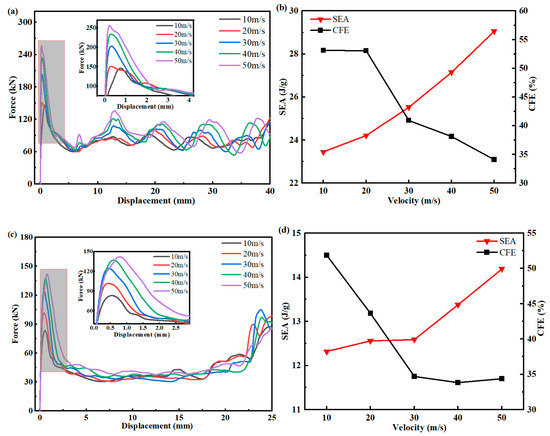
Figure 21.
Comparison of IPLT at different loading speeds. (a) Load-displacement curves at different loading speeds in axial compression. (b) Comparison of crashworthiness at different loading speeds in axial compression, including SEA, CFE. (c) Load-displacement curves at different loading speeds in transverse compression. (d) Comparison of crashworthiness at different loading speeds in transverse compression, including SEA, CFE.
The crashworthiness indices of the IPLT specimens under transverse compression for different loading speeds are shown in Table 9. Figure 21c shows the load-displacement curves for different loading speeds, and Figure 21d shows the variation of SEA and CFE for different loading speeds. When the loading speed increased from 10 to 50 m/s, the PCF of the whole structure increased by 73.65%, which caused larger fluctuations and made the overall stability worse. However, the load capacity increased with the increase in speed, MCF increased by 15.10%; SEA increased by 15.18%.

Table 9.
Crashworthiness index of IPLT under transverse compression for different loading speeds.
5. Conclusions
In this study, a hybrid structure with good mechanical properties and high crashworthiness was designed by printing the lattice structure and thin-walled tube in one piece using SLM technology. Through experimental tests and numerical simulations, we analyzed the differences in mechanical properties and crashworthiness between one-piece printing and split-printing under axial compression and transverse compression. The relevant parameters of IPLT (including thin-walled tube wall thickness, lattice density, and loading rate) were also analyzed. The following main conclusions were drawn:
- (1)
- Under quasi-static axial compression, the IPLT forms more folds with shorter wavelengths, and the SEA increases by 12.14% compared to the NPLT. Under quasi-static transverse compression, the IPLT is not completely separated from the deformation, and the SEA increases by 134.83% compared to the NPLT.
- (2)
- The designed hybrid structure has a 112.60% (580.15%) increase in specific energy absorption under axial compression (under transverse compression) compared to an empty tube.
- (3)
- For IPLT with the increase in wall thickness, the energy absorption is increased, but the excessive wall thickness will make the overall structure less stable. For IPLT with the increase in lattice density, the energy absorption increases. The load capacity of the IPLT−filled tube increases with the increase in loading speed.
Author Contributions
Conceptualization, C.T.; methodology, C.T.; software, Z.W. and Y.W.; validation, Z.W. and Y.W.; formal analysis, Z.L. and H.L.; investigation, Z.L., X.Z. and X.L.; writing—original draft preparation, C.T., Z.W., Z.L., Y.W. and X.Z.; writing—review and editing, Z.L., X.L. and H.L.; visualization, H.L.; project administration, X.L.; funding acquisition, Z.L. All authors have read and agreed to the published version of the manuscript.
Funding
This work was supported by the National Natural Science Foundation of China (11902287) and the Research Program of the Ministry of Science and Technology of China (1816300104 and 2016300402).
Institutional Review Board Statement
Not applicable.
Informed Consent Statement
Not applicable.
Data Availability Statement
Not applicable.
Conflicts of Interest
The authors declare that they have no known competing financial interests or personal relationships that could have appeared to influence the work reported in this paper.
References
- Chen, D.H.; Masuda, K. Estimation of Collapse Load for Thin−Walled Rectangular Tubes Under Bending. J. Appl. Mech. Trans. ASME 2016, 83, 8. [Google Scholar] [CrossRef]
- Duarte, I.; Krstulovic−Opara, L.; Vesenjak, M. Characterisation of aluminium alloy tubes filled with aluminium alloy integral-skin foam under axial compressive loads. Compos. Struct. 2015, 121, 154–162. [Google Scholar] [CrossRef]
- Kim, J.S.; Yoon, H.J.; Shin, K.B. Experimental Investigation of Composite Sandwich Square Tubes under Quasi−Static and Dynamic Axial Crushing. Adv. Compos. Mater. 2011, 20, 385–404. [Google Scholar] [CrossRef]
- Xiang, X.M.; Xiao, C.K.; Ha, N.S.; Lu, G.X.; Zhang, S.L.; Liu, Y.J. The quasi-static compressive mechanical properties of barnacle bioinspired structures. Eng. Struct. 2023, 275, 15. [Google Scholar] [CrossRef]
- Zhang, H.; Gao, Z.P.; Ruan, D. Square tubes with graded wall thickness under oblique crushing. Thin-Walled Struct. 2023, 183, 17. [Google Scholar] [CrossRef]
- Fang, J.G.; Sun, G.Y.; Qiu, N.; Kim, N.H.; Li, Q. On design optimization for structural crashworthiness and its state of the art. Struct. Multidiscip. Optim. 2017, 55, 1091–1119. [Google Scholar] [CrossRef]
- Mahidan, F.M.; Ifayefunmi, O. Buckling of Axially Compressed Cones with Imperfect Axial Length. Lat. Am. J. Solids Struct. 2020, 17, 20. [Google Scholar] [CrossRef]
- Xie, S.C.; Zhang, J.; Liu, X.; Zheng, S.W.; Liu, Z.A. A reinforced energy-absorbing structure formed by combining multiple aluminum foam-filled open-hole tubes. Int. J. Mech. Sci. 2022, 224, 15. [Google Scholar] [CrossRef]
- Zhang, C.; Saigal, A. Crash behavior of a 3D S−shape space frame structure. J. Mater. Process. Technol. 2007, 191, 256–259. [Google Scholar] [CrossRef]
- Singace, A.A. Further experimental investigation on the eccentricity factor in the progressive crushing of tubes. Int. J. Solids Struct. 1996, 33, 3517–3538. [Google Scholar] [CrossRef]
- Singace, A.A. Axial crushing analysis of tubes deforming in the multi-lobe mode. Int. J. Mech. Sci. 1999, 41, 865–890. [Google Scholar] [CrossRef]
- Ha, N.S.; Pham, T.M.; Tran, T.T.; Hao, H.; Lu, G.X. Mechanical properties and energy absorption of bio-inspired hierarchical circular honeycomb. Compos. Part B Eng. 2022, 236, 19. [Google Scholar] [CrossRef]
- Yang, X.F.; Xi, X.L.; Pan, Q.F.; Liu, H. In-plane dynamic crushing of a novel circular-celled honeycomb nested with petal-shaped mesostructure. Compos. Struct. 2019, 226, 13. [Google Scholar] [CrossRef]
- Deng, X.L.; Qin, S.A.; Huang, J.L. Crashworthiness analysis of gradient hierarchical multicellular columns evolved from the spatial folding. Mater. Des. 2022, 215, 19. [Google Scholar] [CrossRef]
- Liu, W.Y.; Huang, J.L.; Deng, X.L.; Lin, Z.Q.; Zhang, L. Crashworthiness analysis of cylindrical tubes filled with conventional and negative Poisson’s ratio foams. Thin-Walled Struct. 2018, 131, 297–308. [Google Scholar] [CrossRef]
- Aktay, L.; Kroplin, B.H.; Toksoy, A.K.; Guden, M. Finite element and coupled finite element/smooth particle hydrodynamics modeling of the quasi-static crushing of empty and foam-filled single, bitubular and constraint hexagonal− and square-packed aluminum tubes. Mater. Des. 2008, 29, 952–962. [Google Scholar] [CrossRef]
- Aktay, L.; Toksoy, A.K.; Guden, M. Quasi-static axial crushing of extruded polystyrene foam-filled thin-walled aluminum tubes: Experimental and numerical analysis. Mater. Des. 2004, 27, 556–565. [Google Scholar] [CrossRef]
- Askari, M.; Hutchins, D.A.; Thomas, P.J.; Astolfi, L.; Watson, R.L.; Abdi, M.; Ricci, M.; Laureti, S.; Nie, L.Z.; Freear, S.; et al. Additive manufacturing of metamaterials: A review. Addit. Manuf. 2020, 36, 36. [Google Scholar] [CrossRef]
- Bartolomeu, F.; Fonseca, J.; Peixinho, N.; Alves, N.; Gasik, M.; Silva, F.S.; Miranda, G. Predicting the output dimensions, porosity and elastic modulus of additive manufactured biomaterial structures targeting orthopedic implants. J. Mech. Behav. Biomed. Mater. 2019, 99, 104–117. [Google Scholar] [CrossRef]
- Ding, R.C.; Yao, J.; Du, B.R.; Zhao, L.; Guo, Y.M. Mechanical Properties and Energy Absorption Capability of ARCH Lattice Structures Manufactured by Selective Laser Melting. Adv. Eng. Mater. 2020, 22, 9. [Google Scholar] [CrossRef]
- Li, C.L.; Lei, H.S.; Liu, Y.B.; Zhang, X.Y.; Xiong, J.; Zhou, H.; Fang, D.N. Crushing behavior of multi-layer metal lattice panel fabricated by selective laser melting. Int. J. Mech. Sci. 2018, 145, 389–399. [Google Scholar] [CrossRef]
- Baykasoğlu, A.; Baykasoğlu, C.; Cetin, E. Multi-objective crashworthiness optimization of lattice structure filled thin-walled tubes. Thin-Walled Struct. 2020, 149, 106630. [Google Scholar] [CrossRef]
- Li, D.M.; Qin, R.X.; Xu, J.X.; Zhou, J.X.; Chen, B.Z. Topology optimization of thin-walled tubes filled with lattice structures. Int. J. Mech. Sci. 2022, 227, 16. [Google Scholar] [CrossRef]
- Liu, H.; Chng, Z.X.C.; Wang, G.J.; Ng, B.F. Crashworthiness improvements of multi-cell thin-walled tubes through lattice structure enhancements. Int. J. Mech. Sci. 2021, 210, 19. [Google Scholar] [CrossRef]
- Cetin, E.; Baykasoglu, C. Crashworthiness of graded lattice structure filled thin-walled tubes under multiple impact loadings. Thin-Walled Struct. 2020, 154, 15. [Google Scholar] [CrossRef]
- Cetin, E.; Baykasoglu, C. Bending Response of Lattice Structure Filled Tubes under Transverse Loading. Hittite J. Sci. Eng. 2022, 9, 151–158. [Google Scholar] [CrossRef]
- Seitzberger, M.; Rammerstorfer, F.G.; Gradinger, R.; Degischer, H.P.; Blaimschein, M.; Walch, C. Experimental studies on the quasi-static axial crushing of steel columns filled with aluminium foam. Int. J. Solids Struct. 2000, 37, 4125–4147. [Google Scholar] [CrossRef]
- Cui, G.M.; Meng, L.Z.; Zhai, X.M. Buckling behaviors of aluminum foam-filled aluminum alloy composite columns under axial compression. Thin-Walled Struct. 2022, 177, 16. [Google Scholar] [CrossRef]
- Zhang, Z.J.; Wang, J.; Wang, Y.J.; Li, B.C.; Li, J.; Li, G.; Sui, Y.G.; Zhang, Q.C.; Jin, F. Elevated temperature axial crushing performance of multi-walled tube-reinforced aluminum foam. Thin-Walled Struct. 2023, 185, 12. [Google Scholar] [CrossRef]
- Bai, Y.C.; Gao, J.Y.; Huang, C.X. Mechanical properties and energy-absorption of integrated AlSi10Mg shell structures with BCC lattice infill. Chin. J. Mech. Eng. 2022. [Google Scholar] [CrossRef]
- Huang, Z.; Zhang, X.; Yang, C. Static and dynamic axial crushing of Al/CRFP hybrid tubes with single-cell and multi-cell sections. Compos. Struct. 2019, 226, 111023. [Google Scholar] [CrossRef]
- Blau, P.J. Friction Science and Technology; Taylor and Francis: Abingdon, UK; CRC Press: Boca Raton, FL, USA, 2010. [Google Scholar]
- Karagiozova, D.; Nurick, G.N.; Yuen, S.C.K. Energy absorption of aluminium alloy circular and square tubes under an axial explosive load. Thin-Walled Struct. 2004, 43, 956–982. [Google Scholar] [CrossRef]
- Nagel, G.M.; Thambiratnam, D.P. Dynamic simulation and energy absorption of tapered thin-walled tubes under oblique impact loading. Int. J. Impact Eng. 2005, 32, 1595–1620. [Google Scholar] [CrossRef]
- Song, J.; Zhou, Y.; Guo, F. A relationship between progressive collapse and initial buckling for tubular structures under axial loading. Int. J. Mech. Sci. 2013, 75, 200–211. [Google Scholar] [CrossRef]
- Yin, H.F.; Guo, D.L.; Wen, G.L.; Wu, Z.T. On bending crashworthiness of smooth-shell lattice-filled structures. Thin-Walled Struct. 2022, 171, 25. [Google Scholar] [CrossRef]
- Wlodzimierz, A.; Norman, J. Dynamic axial crushing of square tubes. Int. J. Impact Eng. 1984, 2, 179–208. [Google Scholar]
- Yang, M.; Han, B.; Mao, Y.; Zhang, J.; Lu, T.J. Crashworthiness of foam filled truncated conical sandwich shells with corrugated cores. Thin-Walled Struct. 2022, 179, 109677. [Google Scholar] [CrossRef]
- Chen, J.; Li, E.; Li, Q.; Hou, S.; Han, X. Crashworthiness and optimization of novel concave thin-walled tubes. Compos. Struct. 2022, 283, 115109. [Google Scholar] [CrossRef]
Disclaimer/Publisher’s Note: The statements, opinions and data contained in all publications are solely those of the individual author(s) and contributor(s) and not of MDPI and/or the editor(s). MDPI and/or the editor(s) disclaim responsibility for any injury to people or property resulting from any ideas, methods, instructions or products referred to in the content. |
© 2023 by the authors. Licensee MDPI, Basel, Switzerland. This article is an open access article distributed under the terms and conditions of the Creative Commons Attribution (CC BY) license (https://creativecommons.org/licenses/by/4.0/).